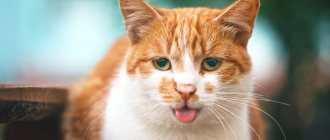Poisoning causes disruption of vital processes in cats and develops when toxic substances, spoiled foods or toxins enter the body. According to statistics, intoxication is most common in cats because they are less selective in food compared to other pets.
Let's take a closer look at what to do if your pet is poisoned and how to help him.
Read in this article:
- How can a cat be poisoned?
- Symptoms of poisoning
- Diagnostics
- Treatment
- We provide first aid
- Contact the veterinarian
- Nutrition rules after poisoning
- Prevention
How can a cat be poisoned?
Cats are very curious animals that love to poke their noses into all sorts of places.
So they explore the world around them, but at the same time expose themselves to danger. About 25% of all possible incidents with cats are poisoning. The causes of poisoning can be different, but most often they are:
- spoiled cat food,
- stale kitchen waste,
- medical drugs,
- indoor and outdoor plants (buttercups, lilies, cornflowers, cyclamen, etc.),
- chemicals (detergents, bleaches, flea and tick gels, etc.),
- pesticide,
- household items (dental floss, tinsel, glitter, etc.).
Many “human” foods can cause poisoning: alcohol, garlic and onions, dough (especially yeast), sweeteners, raisins and grapes.
First aid for cat poisoning
The main thing is to get rid of the cause of the poisoning, throw away the food or whatever you suspect, so that it doesn’t happen again.
Next, you need to induce vomiting, give activated charcoal or Enterosgel. Charcoal – 1 – 2 tablets, depending on weight, must be washed down with water. The most convenient way to feed a cat is from a syringe without a needle.
Try to give your cat water after vomiting, as there is a very strong loss of fluid.
Be sure to cover or wrap the animal in a blanket, since poisoning causes weakness and a drop in the animal’s body temperature, which can lead to unpleasant consequences.
Symptoms of poisoning
Symptoms of poisoning in cats can vary significantly. It all depends on the amount of toxic substance or spoiled product that has entered the pet’s body.
The most characteristic signs indicating animal poisoning:
- difficulty breathing,
- complete loss of appetite
- severe vomiting
- diarrhea,
- unquenchable thirst,
- copious secretion of saliva,
- unsteady gait with loss of coordination in space,
- dilated pupils,
- trembling of the paws and/or the whole body,
- depressed state.
Note! In particularly severe cases, severe convulsions, foaming at the mouth and coma may occur (for example, from poisoning with rat poison, pesticides and other strong chemicals).
The presence of at least one of the above symptoms requires immediate contact with a veterinary clinic. Only here will a correct diagnosis be made and effective treatment prescribed that will help restore your pet’s health.
Ways of poison entering the animal's body
- Nutritional. In this case, the toxin enters the animal’s body through the mouth (that is, with food, drink). Symptoms that a cat has been poisoned may vary depending on the origin of the poison (food, medications, phosphides, rat poison, etc.). But the main signs of such poisoning are the cat’s diarrhea and vomiting.
- Aerogenic. Everything is simple here: the cat inhaled vapors/toxic gases, toxins enter the lungs, are absorbed into the blood and spread throughout the body. That's all - the pet was poisoned.
- Through the skin, mucous membranes. Often the cause of such poisoning lies in the treatment of the animal against fleas, ticks and other parasites (often due to an overdose of the drug or its improper use). Or it also happens that a pet runs through beds treated with pesticides/insecticides/herbicides, lays down on a floor that has just been washed with household chemicals, or somehow manages to get dirty in toxic substances (its paws will fit into paint, its muzzle will get into washing powder) . The poison enters the blood through the skin or mucous membrane (the same conjunctiva).
- Intravenous, intramuscular, subcutaneous, intradermal and other methods. The owner could have injected something, made a mistake with the drug or dosage, maybe even the injection site. As a result, the animal becomes intoxicated. Therefore, it is still advisable to trust a veterinarian to give any injections, and not to prescribe medications on your own on the advice of neighbors or colleagues.
Treatment
Try to find out how and what your cat could have been poisoned with. Carefully inspect the room and apartment. Most likely, your pet left behind traces: chewed packs of medications, scattered contents from the table, trash can, etc.
If you manage to find out what poisoned the animal, then take a sample (for example, a pack of tablets) with you to the veterinarian. Additionally, bring a sample of vomit (if available) to quickly obtain laboratory results. Don't ignore this recommendation! In case of particularly severe poisoning, this will allow you to quickly help your pet and save his life.
Instructions for gastric lavage
The following instructions for gastric lavage are a short version that does not take into account many features. In particular, it may turn out that the cat was poisoned not by food, but by some kind of poison (for example, by eating rat bait).
Important! In some cases, gastric lavage may be contraindicated altogether, and therefore we strongly advise you to consult a veterinarian before performing the procedure yourself.
For washing you will need the following equipment:
- Janet syringe or syringe of sufficient volume.
- Flexible and elastic tube.
- Clean, settled boiled water, or saline solution, or a weak solution of potassium permanganate (potassium permanganate).
- Activated carbon, Smecta, Polysorb, Enterosgel or another type of sorbent.
Before you start washing, you should give the animal approximately 30 ml of a mixture of water and 1% hydrogen peroxide (ratio 1:1). In most cases, this mixture causes profuse and severe vomiting, which allows you to further cleanse the stomach and remove toxins faster.
Peroxide can neutralize many organic toxins, which will also speed up your pet's healing process.
“Secondary” rinsing is performed as follows:
- The cat must be secured in a sitting position.
- The animal's mouth is opened and the tube is inserted as deep as possible along the root of the tongue into the pharynx. At the same time, you should not get carried away, since in the absence of experience it is easy to end up in the wrong place.
- A syringe or syringe is attached to the tube, and then 15-20 ml of the flushing composition is carefully pumped into the pet’s stomach.
- After this, you need to be patient and wait 15-20 minutes. During this time, the pet should vomit.
- If after 25 minutes the cat has not vomited, the procedure is repeated, but this time 25 ml of rinsing is poured into the stomach. To stimulate the development of the gag reflex, the cat's tummy is gently massaged.
When the cat vomits after administering the washing solution, you need to wait about five minutes and repeat the procedure. This is done three or four times (i.e. the cat should vomit three or four times).
After this, the animal is given any of the sorbents listed above. The easiest way is to use activated carbon. It is crushed to a powdery state (from 20 to 40 tablets), diluted with a small amount of water and the resulting mixture is poured down the cat’s throat.
Remember! This should be done about 10 minutes after vomiting, otherwise the cat may vomit again. In severe cases, “coal water” is poured every two or three hours.
Contact the veterinarian
All you can do if your cat is poisoned is provide first aid. Otherwise, you need to trust a professional veterinarian who will make an accurate diagnosis and develop a treatment plan.
In cases where the cat has swallowed spoiled food or a toxic substance, gastric lavage is performed. This procedure is carried out under general anesthesia and the mandatory supervision of a veterinarian. At the end of the operation, the remaining poison is absorbed by introducing a mixture of water and activated carbon or other sorbents.
The specialist is working on a maintenance therapy plan. It consists of ensuring optimal breathing, controlling body temperature and restoring water-salt balance. Painkillers and diuretics are prescribed.
If the detected symptoms of poisoning (convulsions, foam at the mouth, incessant vomiting, etc.) indicate severe damage to the gastrointestinal tract, antibiotics are prescribed. Their dosage and time of administration are clearly determined by the veterinarian.
Doctor's actions
The veterinarian examines the patient, collects anamnesis and conducts the necessary tests to determine what the root cause is and how to treat the cat in case of poisoning. Veterinarians work according to a standard plan. Activity:
- administration of saline solutions, gastric lavage;
- injections of B vitamins;
- adsorbents, antiemetics;
- glycosides, antioxidants, diuretics.
A therapeutic diet will help maintain and improve your health. The veterinarian will advise what to feed the cat after poisoning. A pet should not go long without food. It's better to start with warm meat broth. If everything is normal, then it is allowed to give boiled meat with boiled rice porridge, gradually returning the animal’s usual diet.
Nutrition rules after poisoning
Once the symptoms of poisoning have resolved, the cat is placed on a 24-hour fasting diet. The main thing is to ensure free access to fresh and clean drinking water during the first day. After the diet, you need to feed your pet 3-4 times a day.
Light meals recommended:
- porridge,
- boiled vegetables,
- special foods: Canidae, InnovaEvo, Orijen, Schesir, Royal Canin.
You can switch the cat to its usual diet 5-7 days after intoxication, provided that the animal’s condition is satisfactory.
Poisoning through the respiratory tract
The poison can enter the body through the respiratory tract, for example, by inhaling smoke, gases, insecticides and other substances. Carbon monoxide poisoning occurs when gas stoves and other appliances leak gas in unventilated areas. A cat can be poisoned by exhaust gases in the garage, and by vapors of solvents in the room where painting work is carried out.
Symptoms: vomiting, drooling, rapid pulse, lethargy, shortness of breath, convulsions, loss of consciousness.
First aid: in case of poisoning with gaseous poisons, it is necessary, first of all, to take the cat out into fresh air, clear the airways and, if necessary, carry out a procedure for inducing breathing in combination with cardiac massage. Place a cotton swab moistened with ammonia to your nostrils. Take the cat to the veterinarian.
When evacuating a cat from a dangerous place, cover your face with a damp handkerchief and try to hold your breath.
Prevention: do not leave the cat in poorly ventilated areas, garages, bathhouses, kitchens, etc.
Prevention
Prevention of poisoning in cats begins with controlling the diet. It is not recommended to feed pets from the table, since many foods are dangerous for them. Monitor the freshness of the food: the water should be fresh and the food should not be weathered.
The key to your cat's health is timely care. Carry out hygiene and veterinary procedures, not only at home, but also in professional settings (for example, regularly visit a veterinary clinic for anti-tick treatment).
Ensure complete safety for your pet at home. Do not leave chemicals, medications or cosmetics within reach of your cat, and close all lids tightly. While cleaning the house, we recommend temporarily isolating the animal. Find out whether houseplants pose a potential danger to your pet. The most poisonous of them are: lilies, geraniums, ficus, begonias, etc.
Types of discharge in cats
How can a cat be poisoned?
- plants indoors and outdoors;
- medications - a cat can eat your pills left in an accessible place, or get poisoned during treatment if there is an overdose of the drug;
- food is inappropriate food (chocolate, coffee, onions, garlic, fatty meats, store-bought minced meat, citrus fruits, grapes and raisins, apricot, all types of mushrooms, persimmons, nuts, all products with spices, sausages, smoked meats, sweets, are strictly contraindicated for cats. canned food for people), poor quality or spoiled food;
- chemistry - disinfectants in the house, poorly washed floors or other parts of furniture with leftover products can also cause cat poisoning;
- lead contained in paint, linoleum and batteries - a cat can be poisoned by them if it eats them;
- renovation in an apartment is not only a big stress for many cats, but also a cause of poisoning in animals, for example, when you glue wallpaper, paint and other substances can attract your cat to taste.
Plant poisoning of cats
Among houseplants there are quite a few species that are poisonous to cats (1):
- lilies are very poisonous to cats, causing acute kidney failure, vomiting, and lethargy;
- Cycas - cause vomiting, constipation or diarrhea, mainly affecting the liver;
- azalea, laurel, aloe - can cause diarrhea;
- begonia – burn of mucous membranes;
- asparagus and geranium (the whole plant is poisonous to cats, but the leaves in particular) – stomach upset.
Other toxic plants: yew, autumn crocus, foxglove, lily of the valley, ivy, boxwood, cyclamen, cyperus, iris, narcissus, snowdrop, calla lilies, hyacinth, tulip, chrysanthemum, belladonna, adonis, aconite, acacia, henbane, geranium, wisteria, St. John's wort, jasmine, honeysuckle, tansy, hellebore, celandine, onion, tomato, elderberry, dandelion, physalis, ficus, rhubarb and violet.
Different types of plants can provoke different reactions in a cat's body to food, ranging from diarrhea and vomiting to heart failure (2).
Remember that cats do not always choose only what is beneficial for themselves and not all grass and plants that they can eat are harmless to them. It is important to grow flowers at home that are not dangerous to cats; gift bouquets should also be inaccessible to them.
Poisoning of cats in the country
When going outside, animals, including cats, are at risk of being poisoned by substances that can poison pests like rats (3), cockroaches, and chemicals that are sprinkled on roads.
Rat poison. Poisoning with rat poison can lead to various bleeding (a characteristic sign) and shortness of breath. The antidote - vitamin K1 (konakion) is quite difficult to find in our pharmacies, and doctors in clinics may begin to use other hemostatic agents and then search for konakion.
Fertilizers. Fertilizers on plots are also dangerous during the summer season. Lawn and garden products can be toxic to animals who ingest them when they wash themselves after walking or lying in a recently treated area.
Photo: Nathan Antonovich
Poisoning cats in the apartment
It is important to keep all medications and chemicals out of the reach of animals. Poisoning can be either mild - vomiting, diarrhea, or fatal poisoning, due, for example, to acute renal failure.
The most common reason for visiting clinics is food poisoning, when they are fed either spoiled ready-made food or natural food unsuitable for animals.
Compared with poisoning from strong poisons, inappropriate food is less likely to lead to acute life-threatening conditions, but causes chronic diseases. The liver, pancreas, and stomach most often react to this. For any unfavorable signs, even mild ones, it is important to show your animal to a doctor and undergo the necessary tests, even if symptoms such as vomiting and diarrhea could be prevented on your own. A course of additional medications may be required.
Drug poisoning
Paracetamol (4) is contraindicated for cats - it can cause swelling of the face, cyanosis of the mucous membranes (cyanosis), shortness of breath, kidney failure, gastritis and stomach ulcers.
Animals are also contraindicated in painkillers (non-steroidal anti-inflammatory drugs) such as Ibuprofen and Indomethacin - they are very toxic and can also cause poisoning. Aspirin, Piroxicam, Caroprofen, Naproxen, Phenylbutazone.
Their use with glucocorticoids is especially contraindicated. They can cause stomach ulcerations, stool and vomiting of blood (“coffee grounds”), abdominal pain, and acute renal failure. In case of poisoning with these drugs, it is necessary to induce vomiting; in case of poisoning with Aspirin, the stomach can and should be washed out, even if 3 hours have already passed after poisoning, since aspirin can form conglomerates.










